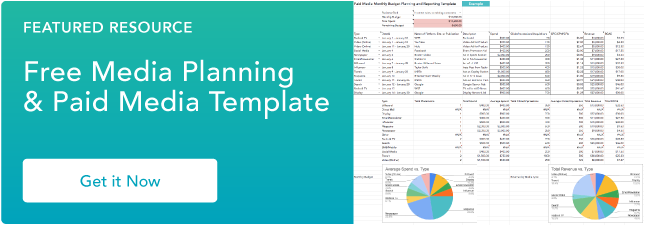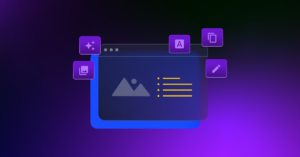
A few months ago, while I was driving to the airport, I saw a billboard for Kim Kardashian’s company, SKIMS. A week later, I saw ads on Instagram, then a SKIMS segment on “Keeping Up With the Kardashians.”
I had one of those moments where I thought “SKIMS is showing up everywhere!” That’s because the company has an integrated media planning strategy.
A few months after these events, when I was shopping for shapewear for my wedding, guess what brand I thought of? (Spoiler alert: it was SKIMS.) That’s why, as a marketer, having an integrated media plan is important for your marketing strategy — below, we’ll dive into what it is, and how to adopt it in your marketing strategy.
Already know what you need? Jump there with this table of contents:
What is integrated media?
Integrated media is a combination of media formats and channels that businesses use to share content with audiences. This can be a combination of traditional (like print and billboards) media, digital media, broadcast media, or product packaging.
Using integrated media essentially ensures that all of a businesses’ different audience segments can encounter its ads, and likely encounter them on various channels. The decision about which specific channels to use is the task of an integrated media planner.
Integrated Media Planner
An integrated media planner makes all media planning decisions based on buyer personas, competitor analysis, reviews, and social listening. From this, the planner learns the best course of action that will help their marketing meet business goals.
They choose the most effective channels, types of media (paid, owned, earned, etc.), and consider when and how frequently content will show up depending on the platform.
For example, perhaps you’ll post Instagram stories around 5-7 p.m. when your audience is home from work and you’ll plan a radio spot for the morning, around 6-9 a.m., to reach your audience that is commuting.
Either way, deciding when and how often a piece of content will appear is an important aspect of an integrated media planner’s job, and this happens during integrated media planning.
Integrated Media Planning
Integrated media planning is the process you’ll go through when you’re considering various media platforms you want to use in a marketing campaign.
An integrated media plan answers questions like “Who is the target audience?” and “What medium will reach this audience?” For example, if you’re targeting millennials, you might consider Instagram and Twitter for your media plan. However, if you’re targeting Gen X, maybe you’re thinking that a combination of radio and Facebook might work best.
Integrated marketing plans also ensure that the ads you create across your different channels are consistent and cohesive for what you’re offering. As in, when you advertise something on one channel, you advertise it the same way on another channel so audiences can see a cohesive campaign regardless of how they come across your ad.
Ultimately, an integrated media plan will use a multichannel approach with a mix of traditional and digital methods, such as radio, TV, billboards, social media, streaming commercials, search engine marketing, email marketing, events, or partnerships.
Below, we’ve outlined five steps to creating an integrated media plan:
1. Figure out your goals.
Before you can start planning your integrated media approach, you have to know your goals.
Just like any marketing campaign, you should have SMART goals written down so you can develop a strategy.
For example, perhaps you want to reach a certain amount of people in a certain amount of time. Or maybe you’re just looking to increase brand awareness among a new market.
No matter what it is, write down your goals and objectives so you can track your performance.
2. Decide your target market.
If your company has a buyer persona, or perhaps even a few, then this might be easy for you. Or maybe you’re deciding between which persona you’re going to target for a certain campaign. Either way, your personas should guide your media plan.
However, if you don’t have a target buyer persona, then now is the time to create one. Your buyer persona will include demographic information such as income, education, and gender. But it should also include pain points and goals.
Understanding your target market means knowing what’s important to your audience, what their life is like, and what problems they have.
Ultimately, you should know who you want to purchase your product so you can deliver personalized content.
Also, your buyer persona might tell you what type of media your audience likes to consume and the type of content they like.
To make this process easier, think about your customer journey. What are the touchpoints? Figuring out this information should help you develop your integrated media plan.
3. Choose various media platforms to disseminate your campaign.
This is the bread and butter of integrated media planning as its when you’ll decide where to distribute your marketing campaign.
Do you want to include social media, TV, radio, organic search, and blogging in your strategy?
Ultimately, you should make this decision based on research on your target market. You should have answered questions such as “Where does my audience want to consume content?” and “What type of content do they want to consume?”
For example, your audience might prefer short-form videos to long-form videos. Or perhaps they like reading a blog more than seeing a picture on Instagram. Either way, you should strike a balance between traditional and digital methods.
Ultimately, your integrated media plan should be audience-centric.
4. Produce the creative.
Once you know your goals, your target market, and most importantly, what type of content you’re going to create, it’s time to produce the creative for your campaign.
Write the copy, design the graphics, and take the pictures. Your creative elements should follow your brand guidelines and tell a story about who you are as a company.
To keep your workload easy, you might consider creating adaptable marketing assets that can be used for several channels.
5. Execute and analyze.
Now that it’s all said and done, it’s time to analyze your approach. Answer questions like, “Which channels worked best?” and “Did I strike the right balance between various media platforms?”
Once you’re armed with this information, you can incorporate it into your future campaigns.
However, don’t forget to let your strategy play out. Don’t switch it up so quickly that you don’t know how it will perform over time. Some campaigns include both short-term and long-term strategies and goals, so it’s important to see the impact before changing it out.
Integrated Media Plan Examples
1. Baboon to the Moon
Baboon to the Moon sells bags for people to use on their adventures, from small weekend getaways to intense backpacking trips. It used integrated marketing to advertise one of its limited-run lines that pays homage to CDMX (Mexico City).
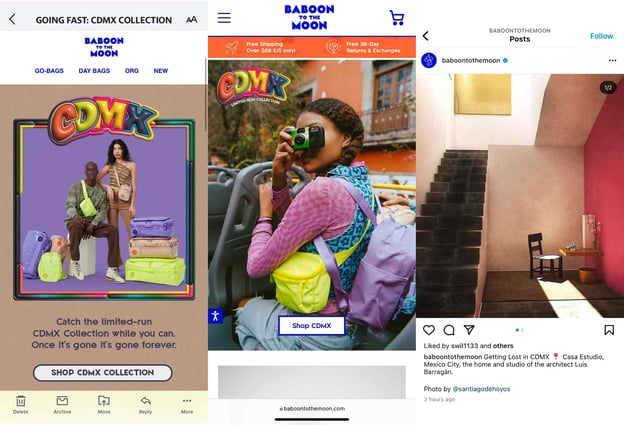
It created marketing assets for three different marketing channels (email, Instagram, and website, respectively) that are cohesive in images, copywriting, and editing style. Regardless of the channel audiences are reached on, every single ad tells a story about the same thing — the CDMX collection.
2. NPR Music Tiny Desk
NPR runs a segment on NPR Music called Tiny Desk, where artists perform a live, acoustic set. It recently launched a Tiny Desk contest for the public, where undiscovered artists can submit an original song for a chance to win a Tiny Desk concert. To advertise the contest, it created an integrated media campaign on Instagram Story and Twitter (pictured below),
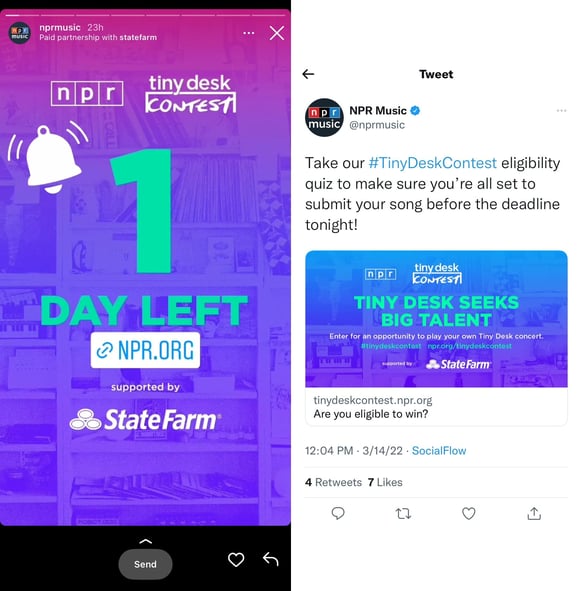
And a humorous YouTube video ad.
3. GrubHub and Seamless
Delivery service GrubHub absorbed delivery service Seamless in 2021 and launched an integrated marketing campaign to make users aware of the acquisition. Seamless created an Instagram post, shown below, that lets customers know with a unique and catchy slogan that “Seamless is GrubHub.”
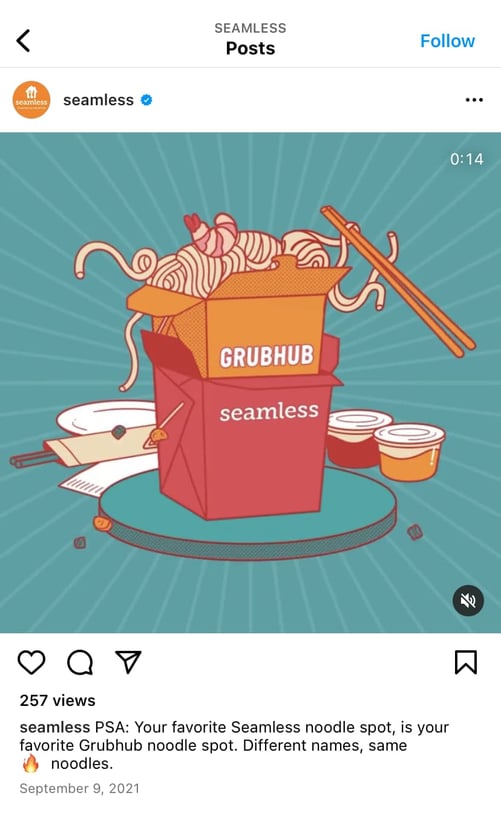
The companies also advertised the new acquisition in New York City subways, creating an integrated marketing campaign using traditional forms of advertisements (physical ads) and digital ads (Instagram).

Over to You
The best marketing campaigns almost always include an integrated media plan. You should have a balance between digital and traditional marketing tactics. After all, the omnichannel experience is what customers expect and want. Marketing is all about delivering the right message, to the right people, at the right time, and that’s what integrated media planning is all about.

